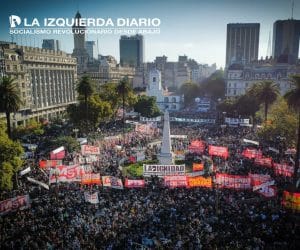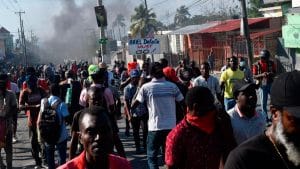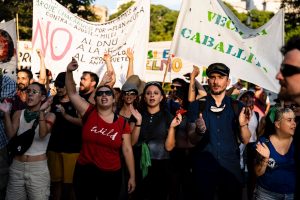This article was originally published in Ideas de Izquierda , October 24th 2015.
The situation in Brazil, where in response to an acute economic and political crisis, Dilma’s government has implemented harsh austerity measures and made pacts with the right wing, is a telling sign of the accelerating decline of the so-called “progressive” governments in Latin America. We can also witness this phenomenon in the Argentine elections, where the future of the “national and popular project” has been handed over to the old political figure of the 1990s, Daniel Scioli, one of the three candidates of austerity seeking the presidency, along with the deep degradation of Chavism in Venezuela and the course of the Uruguayan, Ecuadoran, Nicaraguan, and Bolivian governments. Together, these illustrate the end of the “progressive” cycle. There is no longer any room for significant concessions to the working classes while still favoring the interests of Capital. Rather, it has been necessary to implement severe cuts, and in that way, the nationalist and center-left governments have deepened a regressive course, signaled by concessions to the reaction and to capital.
Thus, contrary to the reformist viewpoint where the only danger is the “conservative restoration”— justifying their support for “progressive” austerity and seeking to discipline any criticism—the reactionary political shift is being implemented by the ruling classes from two fronts: the course set by “popular” governments and the pressure exerted from the right-wing, somewhat strengthened but still far from having secured the conditions to impose a new reactionary hegemony on a regional scale.
The material basis for the conservative-liberal turn fits within the End of the Cycle across Latin America. The “golden decade” of high growth where the post-neoliberal governments stamped their political seal has long passed, and we have entered a phase of economic crisis, political instability and the exacerbation of social contradictions.
The economic crisis covers all of Latin America
With major crises in Brazil, Venezuela, Argentina and elsewhere, the slowdown of the Latin-American economies that had been developing ever since 2012 has turned into a virtual stagnation. According to the CEPAL, for 2015 “a growth rate of 0.5% is expected, in adjusted growth. South America as a whole would experience a contraction of 0.4%. Meanwhile, Argentina would only grow by 0.5%, Brazil would contract by 1% and Venezuela will suffer a severe depression at around -5.5%.” In 2016, Latin America would only achieve a growth rate of 2%.
The global economic crisis is reaching the region by three main roads: the instability of the weak US recovery, which has gained little traction in Latin America; the slowdown suffered by China and the related fall of prices and demand for raw materials exported by the region (which also lose interest because of financial speculation in the “futures market”). To this we must add the appreciation of the dollar against other currencies, making the region’s exports more expensive in relative terms, and the possibility of a rise in interest rates by the Fed, which could decrease the already dwindling capital flow into the subcontinent.
This implies a reversal of the exceptional international conditions from which the last decade drew its growth—the boom in commodities on one side and the availability of cheap finance and investment on the other. The “tailwind” from those years is turning into “headwind” now [2]. The Economist writes that “Latin American currencies have weakened in a particularly dramatic fashion”,[3] adding “the fact that many of the major Latin American economies are large commodity producers has made matters worse”, since the fall in most commodity prices since mid-2014 “has stoked market fears about the economic outlook in Latin America, which in many cases has deepened the sell-off of local currencies”[4]. Because of these reasons, regional growth “has slowed sharply” acording to the director of the IMF[5].
Mexico, in the midst of a political and state crisis, is facing a clear slowdown. This year, its GDP will grow only 2%, while its currency has been depreciating and the drop in oil prices directly affects its revenue and the strategy of market reforms to the energy sector that the Peña Nieto government has implemented, deepening the neoliberal turn. This, along with the slowdown in Colombia, Peru and Chile affects the propaganda surrounding the “Pacific Alliance” as a neoliberal alternative. Chile is the world’s leading exporter of copper and Peru is second, while more than half of Colombian exports are dependant on oil and mining. Falling prices affect them directly and hinder investments, inducing their “slowdown”, leading to devaluations and budget cuts in addition to rising social and political tensions as in Chile and Peru. In 2015, Colombia would only grow some 3% and only 2.3% in 2016. Its exports were down 30% and the Colombian peso lost a third of its value against the dollar and Ecopetrol shares plummeted to half their price.
Brazilmarks a turning point in the Latin American process. Its downturn has considerable consequeces for its neighbors, most of all its main partner in MERCOSUR, Argentina. The Brazilian economy contracted for the third consecutive quarter, officially entering a recession. The GDP increased by 1% in 2012, 2.5% in 2013 and only 0.1% in 2014. This year, the decline in GDP could exceed 2%. Investment has been reduced, industrial production has slowed and even household consumption has fallen, while unemployment has risen to 8.1% and inflation has reached nearly 10%. Tax revenue is also falling and the real is at its lowest point against the dollar since 2009. High local interest rates have attracted some speculators, but the fiscal, monetary and financial deterioration, added to fears of a rise in interest rates in the United States, might lead to the exit of those funds.
As for Argentina, discussed in depth in other articles is [this magazine http://www.laizquierdadiario.com/ideasdeizquierda/numero-24/], the current stagnation and financial difficulties have led to greater uncertainty as a result of: the devaluation of the real and other currencies and the crisis in Brazil, their main regional market and the destination of half of its industrial exports.
The deep recession of Venezuela uncovers the bankruptcy of the “oil nationalism” that was hinted at earlier in the century but never reached a full nationalization. It has proved to be even less capable of promoting industrialization and agricultural development with the substantial oil revenue which was used unproductively or wasted in the interests of the bourgeoisie and bureaucrats who massively drained it abroad. As for Ecuador and Bolivia, the depreciation of oil prices means a severe blow and is driving cutbacks and negotiation with the IMF (in the case of Correa) and new concessions to oil companies (in Bolivia).
From the “golden decade” to the “external constraint”.
The significant growth from last decade, which created an increase of 80% in the Latin American GDP, and a reduction in poverty, extreme misery and unemployment, enabling access to consumption among broad layers of the working class, didn’t imply a real “development”. The persistence of backwardness and the historical dependence of Latin American capitalism has been exposed with the crisis. The “progressive” governments didn’t even make a structural break with neoliberalism. The “models of growth with inclusion” of a neo-developmentalist character remained well within the framework of the essential elements of the model from the 1990s: an orientation to the world market based on a comparative advantage, a large degree of openness to foreign capital; high levels of job insecurity and informality; financialization, domestic and foreign debt, and so on.
To summarize, the regional subordinated position in the global market has not changed, and Latin America retains its basic status as a supplier of raw materials, a secondary market, and a source of monopolistic revenue and financial speculation. Instead, its character as an exporter of primary goods has increased, the industrial backwardness and the dependency on foreign capital have deepened, and it has been unable to overcome the steady loss of importance in world trade. In this framework, there is no qualitative difference between the evolution of the “neoliberal” and the “progressive” models.
Neither has there been a change in labor productivity, a crucial factor in improving a country’s position in the international economy. Latin American average productivity has remained only a fraction of that in the central capitalist countries, and inferior to that of China and East Asia with a slower growth rate. According to ECLAC, “During the period between 2002 and 2010, the region managed a few advancements, with an annual increase of labor productivity of 1.5%”[6]. This figure however, is below many other regions including Saharan Africa (2.1%) and Eastern Asia (8.3%), excluding Japan and South Korea [7]. Only a few sectors of industry benefited from high prices and massive investment, such as mining, agro-business, and some modern services and industrial niches showed a higher dynamism but many more sectors such as production for the domestic market, commercial activities, and traditional services showed low productivity. In sum, total productivity has been weak. The capital formation rate has been relatively low, around 20%, well below Asia.
At the turn of the business cycle, there’s an intensification of the “external dependency”, a recurring problem of dependent Latin American capitalism, that drives the recession in a movement of “stop and go” and makes clear that the cycle of commodities producers is subordinated to the industrialized center, while shining light on the continuity of imperialist pillaging through the plundering of utilities, financial speculation, the debt servicing, etc.
In past years, the diversification of trading partners, with China as the second largest buyer (after the US), along with the crisis of U.S. hegemony, created more breathing room to negotiate with imperialism. Secondly, intra-regional trade somewhat expanded the market for local industry. Regardless, these factors besides being contradictory (like industrial competition with China) can only offer palliatives in the times of crisis. The regional integration is superficial and feeble, and the crisis exacerbates inter-bourgeois competition to attract foreign investment, in defense of their own markets and interests as shown by the recent escalation of devaluations and protectionist measures between neighboring countries. We witnessed this in the growing tensions within Mercosur that the Brazilian crisis deepens. That is the reason that attempts at an individual negotiation with imperialism are rising, like the insistence of the Sao Paulo bourgeoisie for a rapprochement with the United States, the contacts with the European Union, Uruguay’s attempt to advance in a TISA with imperialism “cutting off” of its regional partners, and the Argentine attempt to lean more on China, etc.
Some political and social consequences of the nationalist and “progressive” degradation
The “progressive political economy” pictured a regulatory state which could channel the surplus generated by exports into capitalist accumulation on a national scale, involving foreign capital and putting a relative emphasis on “demand”[8] to generate a “virtuous circle” of “inclusive development”. But the harsh “actually existing capitalism” demolished these expectations. Now, it appears to be a matter of stimulating the “offer” of capital. As ECLAC states, it is precisely to “promote the investment cycle in order to revive growth”, while the IMF insists on stimulating “savings, investment and productivity” in addition to “competitive currency exchange rates ” and investments in infrastructure to cheapen exports[9].
The establishment is demanding these changes in rhythm from the Ministers of Economy. But this means, on one hand, new concessions to imperialism and their financial institutions, in addition to the “fiscal discipline” necessary to secure state funding and afford greater external debt, and secondly to advance a “negative wealth redistribution”, lowering direct and indirect wages, through salaries, social services, health, education, transport, etc.
On this basis, there is no class conciliation possible. If the capacity of mediation and arbitration of the “progressive” governments was already damaged – “underfunded” in the new economic context- they must now employ themselves in the unpleasant duty of managing the crisis through austerity, while failing to quell the demands of big capital, who would rather have more reliable managers that could openly and completely assume their program.
The economic crisis is developing into widespread political instability, and while assuming its most remarkable features in the crisis of the “popular governments”, the right-wing governments aren’t safe from the storm: the fall of Otto Perez amidst major demonstrations in Guatemala, the deep state crisis corroding Mexico and the weakening of the Chilean regime are examples of this. Once again, the Brazilian example is relevant, as the PT government crisis shows clearly the continuity of the most reactionary institutions and forms of bourgeois political domination; or Argentina, where the end of the Kirchnerist era brings to the fore the most heinous and corrupt aspects of the regime and its parties. What is being questioned is not just a few governments. There is a widespread discrediting of political parties and the institutions.
But the growth of social unrest could intensify class realignments. In the region which is still the most unequal in terms of the concentration of wealth, income distribution and ownership of land, the crisis calls into question the modest conquests of “inclusion” and the supposed strengthening of the middle class that underpinned the relative social peace in the “golden decade.”.
Tens or hundreds of millions of Latin Americans could be pushed back into poverty and misery. Millions more qualified workers, or those who’ve won stable jobs and more or less acceptable wages, a class that’s been intentionally “dissolved” into the heterogeneous and diffuse conglomerate of the “middle class” (along with professionals, petite-bourgeois merchants, administrators, etc) are now facing not only the growing disparity between their hopes and aspirations and the reality of deteriorating working and life conditions, but also the prospect of more direct attacks in workplaces, where companies seek to increase profitability at the expense of wages.
After a decade of growth, the integration of millions into the work force, a partial recovery in consumption, cultural and educative changes, and progressive promises to working people, a new floor or historical-moral level of wages, as Marx said, has been established for a vast mass of workers who do not bear on their shoulders the weight of past defeats and are hardly willing to give up without a fight their current conquered positions, which can place the confrontation between capital and labor at the forefront as not seen in many years,.
The struggles of the labor movement and the student and youth mobilizations of these years can be a symptom of new channels of class struggle. Since late 2012, labor strikes, and large general strikes in Brazil and the Southern Cone are manifesting the strength of the labor movement and advance the possibility of greater resistance in the next stage. Along with it, as a sign of the awakening of new generations, important processes of student mobilization and sectors of the precarious youth ranging from the permanent student protests in Chile, the protests of June 2013 in Brazil, Mexico mobilizations of “#yosoy132” and the fight for the 43 students of Ayotzinapa, or the recent student demonstrations in Uruguay and Paraguay, as well as various indigenous, peasant and popular struggles.
In the foreseeable horizon of worker and popular resistance and political experience for the working class, the political and ideological cracks in the left flank of progressivism open a new stage for the construction of a social and political force of workers, with a strategy of class independence and a program directed at making the capitalists and imperialism pay their own crisis. The alternative to conservative restoration is not supporting the “progressive” austerity programs but rather a struggle for a workers and popular solution.
Translated by Matías Yer
References:
[1] There is a debate on the end of the progressive cycle that we can not refer to this article. A few days ago in Página/12, Emir Sader, intellectual reference of the center-left, is indignant at the very idea that we can speak of an end to progressive cycle.
[2] The international capitalist crisis which began in late 2007 hit the region with the recession of 2009. But it soon recovered, aided by the continued expansion of the Chinese economy and the “emerging markets”. However, recovery was built on weak and unstable foundations. The price of raw materials kept growing until 2011-12, but already with a strong speculative component in the “futures market”. Meanwhile, the expansion of domestic markets began to clash with its structural “roof”.
[3] The outlook for Latin America 4, The Economist Intelligence Unit, 2015.
[4] Ídem.
[5] El País, 30/09/2015.
[6] CEPAL/OIT, Coyuntura laboral en América Latina y el Caribe 6, mayo de 2012.
[7] Ídem.
[8] Emphasis on, because despite the progressive discourse, the level of wages or they participation in national income was never qualitatively altered.
[9] Exporting a container from Brazil costs more than double the cost in China and 1.5 times in India, while delays in shipping ports are fearsome.











